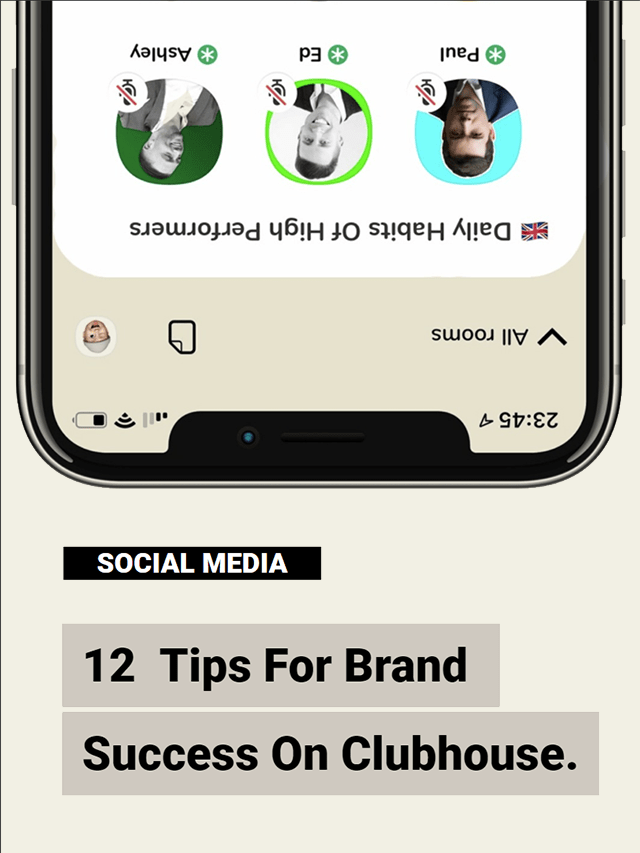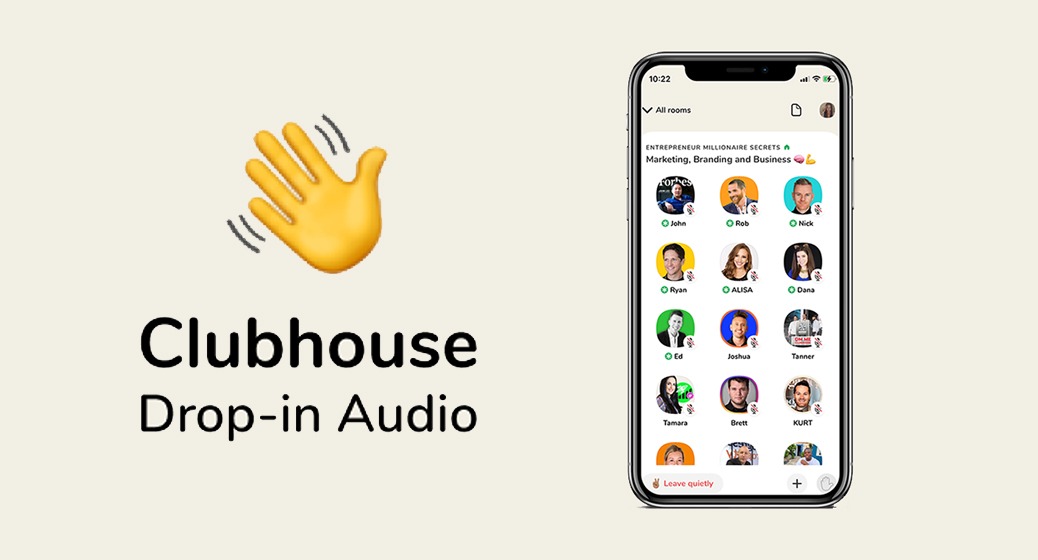Popularity and exclusivity might seem like a contradiction in terms, but not for Clubhouse, the red-hot audio-only networking app that took off like a rocket since its April 2020 launch.
The perfect pandemic replacement for break-room contacts and water-cooler exchanges, this Silicon Valley hotspot bridges the yawning gap in casual communications, ripped open by lockdowns and quarantines. Perfectly timed as a digital stepping-stone in a world scrambling to pivot from live to virtual, Clubhouse rapidly built up its name as the go-to platform for networking in the tech and entertainment fields. Part of its appeal certainly lies in the lack of prepping: with no visuals, bed-headed users can log in whenever and from wherever. And that’s just what over a million people are doing at any given moment.
Everybody wants in on [glossary_exclude]Clubhouse[/glossary_exclude]
Introduced as an invitation-only series of chat rooms where the lucky few could chat live with famous names like Ashton Kutcher, Alexis Ohanian, and Tiffany Haddish, membership of this pandemic-beating audio-chat app topped ten million by March 2021 – and still counting! This exponential growth is dizzying, up from only two million users in January and ballooning from a sparse 1500 members in May 2020.
Currently valued over a billion dollars, this is a welcome – if long overdue – addition to the now-standard array of text, photo, and video platforms. Like a digital convention on steroids, [glossary_exclude]Clubhouse[/glossary_exclude]is a blend of CES, Comic-Con, Carnival and corporate seminars, all rolled into never-ending rounds of conversation.
Talking instead of tweeting
This drop-in audio-chat platform is structured along the main feed (known as the Hallway) lined by virtual rooms, each hosting live conversations on a vast variety of topics, many of them business-focused. On entering a room, users listen quietly to discussions among entrepreneurs, venture capitalists, angel investors, tech visionaries, podcasters, and other influencers. If their requests to speak are approved by room moderators, listeners can chip in with their own news, views, doubts, and queries.
Unlike other platforms offering one-way consumption of static content over time, [glossary_exclude]Clubhouse[/glossary_exclude] focuses on high-value voice exchanges in real-time, its audio-only format slots this app seamlessly into the gap between flat-toned text-chats and more nuanced live conversations, for added empathy and clearer understanding.
Less ‘media’, more ‘social’
Despite its deliberate exclusivity – membership is by invitation only and limited to iPhone users during the private beta testing stage – [glossary_exclude]Clubhouse[/glossary_exclude] is betting on a means of communication largely ignored by other social media: the human voice. In contrast to platforms that showcase visuals (like videos, captions, images, and written posts and comments), Clubhouse opts for an audio-only format, giving its conversations a coffee-shop vibe.
Stressing the message rather than the medium, speakers engage in spoken exchanges with immediate live responses, at the same pace as real-life talks and round-table discussions. Content is ephemeral and contacts are casual, in contrast to other social media platforms where careless comments can haunt posters forever.
Surprisingly, [glossary_exclude]Clubhouse[/glossary_exclude] underscores the ephemeral nature of its exchanges. Recording or transcribing its voice-chats is forbidden, without consent from every participant. This brings unparalleled freedom of thought into play, opening up a broader range of expression, packed with subtle nuances that are often lost in visual communications.
So, is [glossary_exclude]Clubhouse[/glossary_exclude] a new marketing channel?
In the right hands, everything is a marketing tool! But as long as it remains in the private beta stage and restricted to iPhone users only, the hidden advantages of the [glossary_exclude]Clubhouse[/glossary_exclude] platform will remain largely undiscovered.
But for early-bird adapters, this is a great opportunity to burnish a brand image through cutting-edge technology, promoting goods, services, and events.
Here are 12 examples of ways brands are exploring how to succeed on Clubhouse:
-
Anyone can start a room and set the rules (which can include recording content with consent from the participants), making [glossary_exclude]Clubhouse[/glossary_exclude] a great place to test-drive podcast and video ideas;
-
Passive listeners become active participants by simply tapping on the ‘raise hand’ button at the bottom of the screen;
-
Crowdsource and curate up-to-the-minute content in private rooms, with immediate audience insights;
-
Organize focus groups and one-on-one interviews, duos, and trios anywhere in the world with no need to rent expensive viewing rooms;
-
Explore innovative possibilities through shark tanks that offer easy global access to pitchers and investors;
-
Collaboration on specific projects, so members can chat privately with any of their connections;
-
Build communities for virtual events, where attendees can connect with each other;
-
Public presentations and launches in real-time and at zero cost, followed by easy distribution to follower networks, also at zero cost;
-
Connect easily with customers in private rooms, for fast product feedback and responses to complaints;
-
Build product or brand awareness through word-of-mouth campaigns focused on regular actions, like Q&A sessions open to the public;
-
Confidentiality is ensured, as nothing is saved after a chat room is closed and conversations are deleted;
-
Users are linked by mutual respect and a sense of relative intimacy, pumping up brand credibility among followers;
Say hello to the latest killer app
Once Clubhouse moves out of the private beta testing stage, the outlook is enticing for companies. Brands will be able to sponsor rooms where founders can share their stories, attracting investors and customers. Like live calls to action, speakers can offer hand-outs in exchange for email addresses: “I wrote an e-book on that, and I’ll be happy to send it to you free …”
However, there’s no silver bullet for marketing effectively through the [glossary_exclude]Clubhouse[/glossary_exclude] platform. Hosts and speakers must provide a steady stream of high-value content tailored to the real-life needs of their followers and respective listeners.
A powerful marketing tool: FOMO
In our shifting world, fear of missing out (FOMO) is one of the main drivers behind the increasingly frantic consumption of news, social media, and podcasts worldwide. However, all these channels offer catch-up options, as their content remains available for access by late-comers.
But the no-recording policy implemented by [glossary_exclude]Clubhouse[/glossary_exclude] ratchets FOMO up to unparalleled levels: miss out on a comment, and it’s gone forever. This keeps users popping in and out of its rooms all day, as its discreet ears-only format fits invisibly into multi-tasking routines.
Is it really worth joining [glossary_exclude]Clubhouse[/glossary_exclude]?
Why not? Who wouldn’t want to be part of this exciting new trend? But if nobody has sent you a much-coveted [glossary_exclude]Clubhouse[/glossary_exclude] invitation yet, it’s still worth downloading the app in order to get your name on its waiting list. A member who knows you might receive an automatic in-app notification and ask you to join.
After all, if Elon Musk invited Vladimir Putin (both world-class experts in selling their respective ‘wares’!) to exchange ideas through [glossary_exclude]Clubhouse[/glossary_exclude], this social audio platform has to be a great venue for digital marketers!
Bonus: 4 Alternatives to Clubhouse
[glossary_exclude]Clubhouse[/glossary_exclude] isn’t the only audio social media app competing for your listening attention. Here are some other up and coming alternatives for your ears.
-
Audio Spaces‘ concept is to allow users to gather for live conversations on Twitter. Some of the beta features include transcriptions, reactions, the ability to report spaces, and the space creator controlling who can speak. Like [glossary_exclude]Clubhouse[/glossary_exclude], it’s initially open to an exclusive group. But, they’ve made the unique decision to focus not on celebrities but on those “disproportionately impacted by the abuse and harm on the platform: women and those from marginalized backgrounds.” Twitter also released Voice Tweets.
-
Discord: Since its launch in 2015, Discord has gained 140 million users. It started as an audio platform for gamers but opened up the platform to everyone in 2020, positioning itself as a rival for [glossary_exclude]Clubhouse[/glossary_exclude].
-
Spoon: Spoon is a live audio streaming platform anyone can use. You have the option of doing live or pre-recorded audio, and you can monetize your content.
-
Riffr: Riffr describes itself as a social micro podcasting app. Users can post short-form audio content on a variety of subjects. Unlike [glossary_exclude]Clubhouse[/glossary_exclude], it’s not live—it’s mini-podcast sessions. However, there is a community aspect, and you can follow users.
Want more insights?
Subscribe to our weekly marketing tips and advice, delivered straight to your inbox.
Oops! We could not locate your form.
Keep Reading
Want more? Here are some other blog posts you might be interested in.
The startup myth goes like this: work 20-hour days, pivot constantly, chase the high of the new. That’s what makes a ...
Most founders build their first leadership teams for speed, comfort, and alignment. Understandably, you’re strapped for time and need people who ...
Many small business growth strategies include the dangerous assumption that success comes from acquiring more customers. However, customer acquisition without customer ...
For founders and growing companies
Get all the tips, stories and resources you didn’t know you needed – straight to your email!






